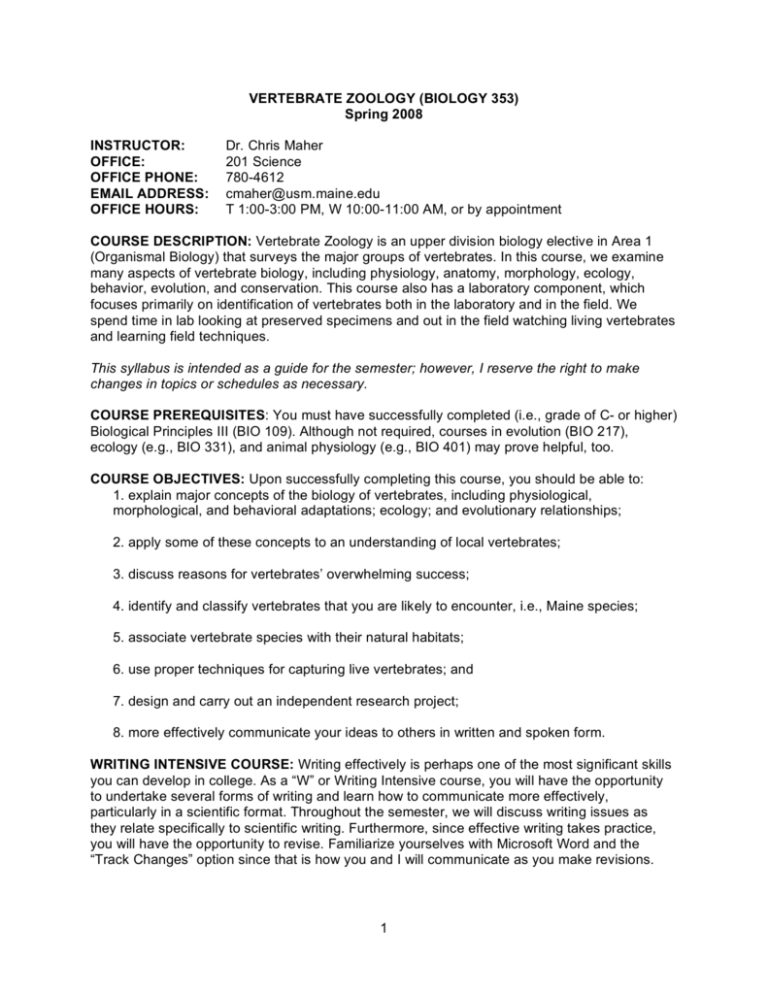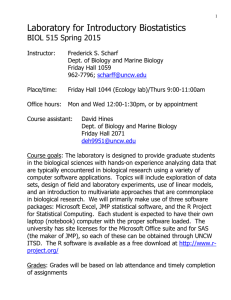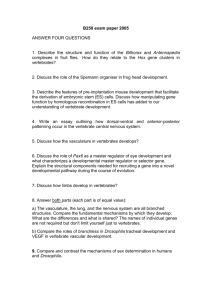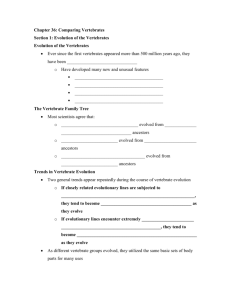
VERTEBRATE ZOOLOGY (BIOLOGY 353)
Spring 2008
INSTRUCTOR:
OFFICE:
OFFICE PHONE:
EMAIL ADDRESS:
OFFICE HOURS:
Dr. Chris Maher
201 Science
780-4612
cmaher@usm.maine.edu
T 1:00-3:00 PM, W 10:00-11:00 AM, or by appointment
COURSE DESCRIPTION: Vertebrate Zoology is an upper division biology elective in Area 1
(Organismal Biology) that surveys the major groups of vertebrates. In this course, we examine
many aspects of vertebrate biology, including physiology, anatomy, morphology, ecology,
behavior, evolution, and conservation. This course also has a laboratory component, which
focuses primarily on identification of vertebrates both in the laboratory and in the field. We
spend time in lab looking at preserved specimens and out in the field watching living vertebrates
and learning field techniques.
This syllabus is intended as a guide for the semester; however, I reserve the right to make
changes in topics or schedules as necessary.
COURSE PREREQUISITES: You must have successfully completed (i.e., grade of C- or higher)
Biological Principles III (BIO 109). Although not required, courses in evolution (BIO 217),
ecology (e.g., BIO 331), and animal physiology (e.g., BIO 401) may prove helpful, too.
COURSE OBJECTIVES: Upon successfully completing this course, you should be able to:
1. explain major concepts of the biology of vertebrates, including physiological,
morphological, and behavioral adaptations; ecology; and evolutionary relationships;
2. apply some of these concepts to an understanding of local vertebrates;
3. discuss reasons for vertebrates’ overwhelming success;
4. identify and classify vertebrates that you are likely to encounter, i.e., Maine species;
5. associate vertebrate species with their natural habitats;
6. use proper techniques for capturing live vertebrates; and
7. design and carry out an independent research project;
8. more effectively communicate your ideas to others in written and spoken form.
WRITING INTENSIVE COURSE: Writing effectively is perhaps one of the most significant skills
you can develop in college. As a “W” or Writing Intensive course, you will have the opportunity
to undertake several forms of writing and learn how to communicate more effectively,
particularly in a scientific format. Throughout the semester, we will discuss writing issues as
they relate specifically to scientific writing. Furthermore, since effective writing takes practice,
you will have the opportunity to revise. Familiarize yourselves with Microsoft Word and the
“Track Changes” option since that is how you and I will communicate as you make revisions.
1
EXPECTATIONS: This is an upper division course in biology, so I expect you to accept a
greater share of the responsibility for learning than you perhaps would do in an introductory
course. This is a 5-credit course, so you are expected to commit 10-15 hours each week, in
addition to the scheduled class meeting time, to this course. To achieve course objectives, you
must take an active role in learning. You must arrive prepared for the day’s events, which
means you have read assignments prior to class and you are prepared to discuss material. I
expect to engage you in an interactive discussion and to guide you through the material.
REQUIRED TEXTS:
Alden, P. and Cassie, B. 1998. National Audubon Society field guide to New England. Knopf,
New York.
Pechenik, J. A. 2007. A short guide to writing about biology. 6th ed. Pearson Longman, New
York.
Pough, F. H., Janis, C. M. and Heiser, J. B. 2005. Vertebrate Life. 7th ed. Pearson Prentice
Hall, Upper Saddle River, New Jersey.
ATTENDANCE POLICY: I consider college students to be adults and thus responsible for
making their own decisions about attending class. Therefore, I do not maintain attendance
records. However, we discuss a great deal of material during each class period, and most
students find it difficult to make up missed classes, even when they copy a classmate’s notes.
Labs are virtually impossible to make up, especially since some of them involve fieldwork.
Therefore, if you want to do well in this course, the first step is to attend and participate.
COURSE WEB SITE: I have established a web page for this course, using Blackboard. You can
access the web page through this URL: http://www.courses.maine.edu. This site will be a place
where you can communicate with me, I can communicate with you, and you can communicate
with each other. I will post announcements and reminders, the syllabus and other important
handouts, relevant web sites (which you can add to), etc. Thus, this site will be an up to date
way to keep track of what’s happening in the course.
ACADEMIC HONESTY: Cheating, plagiarism, and fabrication of results all violate academic
integrity and will not be tolerated in this course. Plagiarism is a form of cheating, so you must
educate yourself about this practice. Plagiarism includes portraying words or ideas as one's
own, i.e., taking credit for the work of others. Even if you paraphrase, if you do not give
someone credit for his/her ideas, you commit plagiarism. You must paraphrase, cite sources
and include a list of those sources. Any violations of academic integrity will be handled through
the Office of Community Standards, according to University policy. For more information, see
http://www.usm.maine.edu/ocs.
DISABILITIES AND SPECIAL CONCERNS: If you have a known or suspected learning
disability or other special concern, please meet with me as soon as possible or contact the
Office of Support for Students with Disabilities (780-4706 or TTY: 780-4395) to arrange
accommodations.
BASES FOR GRADE:
1. Exams: To reinforce the material you learn, I will administer 3 exams during the semester.
Each exam will cover material from lecture and the reading assignments, and it will consist of
short answer and essay questions. You will be tested on basic information, understanding of
concepts, and application of those concepts to new situations. You cannot just memorize the
information we cover and expect to regurgitate it back to me on paper. To do well, you must
understand the concepts and material you learn because I will ask you to show me a deeper
2
level of understanding that I hope will persist after the course ends (details are soon forgotten).
This type of understanding often is a new experience for students, and it can be frustrating. I am
more than willing to help you make the transition from the memorization type of learning to true
comprehension of ideas, so please visit me.
MAKEUP EXAM POLICY: Missed exams cannot be made up except under unusual
circumstances; you must notify me of any excuse, due to illness or other situation, before the
exam. At my discretion, makeup exams may be oral exams, and they will cover the same
material as the original written exam. You must take the makeup exam no later than one week
after the scheduled written exam. You cannot make up the exam scheduled during finals week.
REGRADE POLICY: If you believe I graded you unfairly on a question, you should provide a
written statement clearly explaining why you believe you deserve more credit for an answer.
The statement, along with the exam, must be returned to me no later than one week after I
return the exam. I will reevaluate your answers and provide you with my decision promptly.
2. In-class writing tasks: Periodically during the semester, I will ask you to write a brief answer to
a question I pose. The question may be related to material discussed in class or to reading
assignments. Questions may be somewhat “factual,” but they also may require you to integrate
and synthesize information you are learning. I will drop your two lowest scores on these
assignments. If you miss a class at which you receive a writing assignment, you may count that
task as one of your dropped scores.
3. Research project: This project combines literature review, experimental design, data
collection, data analysis, and production of a scientific poster. We cannot begin to cover all the
topics in vertebrate zoology, and students in this course probably have a wide range of
interests. By planning and conducting a research project, you have the opportunity to explore, in
depth, some facet of vertebrates that interests you. You can work on anything you want,
keeping in mind resources available to you: vertebrates in the field, vertebrates in the lab, or
domestic vertebrates (but sample size is important), but not humans.
Another goal of the project is to help you to improve your writing and thinking abilities.
With this in mind, and to help you to understand the assignment, I will provide you with feedback
at least 3 times; however, I strongly encourage you to consult with me as many times as you
feel necessary. I also can help you to attain equipment you may need to carry out your project
successfully. You will be required to turn in a proposal, two drafts, and a final poster. NO LATE
ASSIGNMENTS WILL BE ACCEPTED at any phase of the project.
You may work alone or in pairs on this project; however, if you choose to work with
someone else, each of you must keep track of the time and responsibilities that each individual
puts into the project, and both students will receive the same final grade.
A word about the Web: The World Wide Web may contain interesting information;
however, since anyone can post anything to the web, it is not an accepted scientific source.
Biologists subject their work to intense review by their peers prior to publication. The number of
online journals is increasing, however, and you may use these publications since papers
published electronically are peer reviewed. Our library contains a small sample of journals
relating to vertebrate zoology, so chances are quite high that you will have to make requests
through Interlibrary Loan. They are fast, but you still need to plan ahead and remember that
materials may not be available to you immediately.
IACUC form. Because you will work with vertebrates, you must comply with the University’s
animal care procedures. Therefore, if you will handle or interact with vertebrates in any way
other than simply observing them, you must complete an Animal Proposal Study Form. I will
3
work with you on the form prior to your submitting it to the Institutional Animal Care and Use
Committee. This form is available at the IACUC’s web site: http://www.usm.maine.edu/orc/iacuc.
You should email the completed form to me no later than Monday, 4 Feb at the beginning
of class.
A) PROPOSAL AND ABSTRACT: TWO COPIES DUE MONDAY, 4 FEB AT THE BEGINNING
OF LECTURE
The proposal will consist of a brief description of your research project. See chapter 10
in A short guide to writing about biology. It will include the objective or goal of your project, the
hypothesis you want to test, the species you intend to use to address your hypothesis, a
description of your study area (if appropriate), the methods you plan to use to answer your
question, and a budget. The proposal should be word processed, double spaced, with
numbered pages, 1” margins and 10-12 point font.
Once you submit your proposal, you are not locked into that particular project; things
change and you may need to make adjustments. However, I must approve all major changes in
the project. Finally, because scientists rely on each other’s evaluation of their work, you will
conduct peer reviews of each other’s proposals, offering constructive feedback and suggestions
anonymously.
Your proposal should contain the following components:
Introduction, in which you provide the following:
1. A short discussion of the theoretical concepts underlying your specific project. These
concepts should not apply solely to the organisms you study; they should be general and
supported by information from literature sources (primary and secondary).
2. A justification about why a particular system is appropriate for investigating concepts you
described. Describe the organisms you will study and explain why they are a good choice to
answer questions raised by the general area of study you want to investigate.
3. A list of specific objectives, hypotheses and predictions. Explain, in detail, predictions you
plan to test using the system you chose. Focus on specific patterns you expect to find if you
investigate general concepts, outlined earlier, in the particular species chosen.
Methods, in which you provide the following:
1. Description of your study area (if appropriate).
2. Definitions of specific independent and dependent variables that you expect to measure.
3. Description and explanation of the experimental or observational design in which you will
measure variables. What are your experimental conditions? What are your control
conditions? If you do not plan to conduct an experiment, what sort of natural variation do
you expect to use (as your independent variable) to investigate potentially different
responses of your dependent variable? You may use a diagram or flow chart to explain the
logic of your experiment or study.
4. Discussion of specific methods you plan to use to collect data, including necessary
equipment.
5. Schedule of events. Include a time line that details the course of data collection. Include any
time constraints that will affect your ability to collect data (e.g., time required for animals to
acclimate to experimental conditions or to undergo some biological process). How long will it
take you to obtain sufficient data? If you work with a partner, will you collect data together or
separately? If separately, what will be the intervals between observation periods? When do
you expect to finish collecting data?
Anticipated results. Think about what your data will look like depending on whether or not you
find support for your predictions. Include hypothetical graphs.
4
Significance. Discuss what you expect your results to really mean, depending on whether or not
you find support for your predictions. This statement could be as simple as, “If I find the same
results as Mary Smith did with the same system, this will tell me her results were not anomalies
and her interpretation of theory X was sound.” If you know you are conducting a study no one
has ever performed before (to the best of your knowledge), you could say “Regardless of the
results, I can say something about the relevance of theory X to study animal Y.”
Budget. All research proposals contain a budget. Your budget should contain an itemized list of
supplies (including animals if you must purchase them) and equipment you will need to carry out
your project, as well as justification for the expenses.
Abstract. The abstract, a summary of your project (or what you will present, since this is due
fairly early), must be <200 words and written in proper scientific format. After I approve your
abstract, you must submit it online (see below).
B) DRAFTS
Drafts should not be the first version of your poster, hand-written and thrown together at
the last minute. Consider this to be almost your final version of particular sections of your
poster, with the layout planned. It should have all the right elements in all the right places. See
chapters 9 and 12 in A short guide to writing about biology. Drafts will not be graded; however, if
you elect not to turn them in, you will lose 5% of your total points for each missing draft. You
may submit drafts before the due date.
Introduction and Methods: Due Wednesday, 6 March at the beginning of lecture
Poster: Wednesday, 2 April at the beginning of lecture
C) FINAL POSTER: DUE FRIDAY, 18 APRIL AT “THINKING MATTERS”
At scientific meetings, posters are popular ways to present research results. A poster is
more of a visual presentation of your research compared to a written paper; the idea is to
convey to the observer, clearly and succinctly, the essence of your work. Thus, text is kept to
the bare minimum; type is large and easy to read; graphs also are large and clearly
understandable from a distance of about 0.5 m. The entire poster should fit into a space that is
36” tall and 48” wide. Students working in pairs will produce one coauthored poster.
During Spring Semester, USM holds an annual symposium, “Thinking Matters,” that
highlights student research, scholarship, and creative activity. You will participate in this event,
which is scheduled for Friday, 18 April 2008, in the Sullivan Gym. You will be required to be
present during the poster session, which was held last year from 1:30 to 3:00 PM. However,
your poster will be on display for the entire day. For more information, see the following website:
http://research.usm.maine.edu/thinkingmatters.
Consult chapter 12 in Pechenik for information about preparing posters; chapter 9 also
has useful information about which material should be presented in each section. We will
discuss the project and the poster in more detail as the semester progresses. However, please
come visit me whenever you have questions or need suggestions.
The drafts and poster will consist of the following parts:
Title: This should clearly describe your research project and include the name of your study
organism with its scientific name. Include your name beneath the title.
Abstract: A brief summary of your project, including the objective(s), hypotheses, methods,
results and major conclusions, but without any extraneous information.
Introduction: Here you describe the underlying concept that you are studying (e.g., predation,
thermoregulation, foraging, etc.). You should give a brief review of the literature on this subject,
5
such that a scientifically literate reader who is unfamiliar with the study can understand the
research, and only include information directly related to the study. You also should include your
objective(s) (what question are you trying to answer?), hypotheses, and predictions.
Study area and methods: In this section, you will describe your study area: its specific location,
flora and fauna, and other general characteristics. You will describe the experimental design,
techniques you used, manipulations you performed, etc., and you should include methods of
data analysis, including statistical tests.
Results: Here you present results of your study. Include summaries of data you collected and
results of statistical tests you performed. Never include raw data, and do not interpret your data
here. Most of your results should be presented in tables and graphs; keep text to a minimum.
Discussion: Here's where you can have some fun. Look at your results and think about what
they tell you. INTERPRET your findings. Do they support your hypothesis? Why or why not?
Draw general conclusions and relate them back to the justification for the study. It's all right to
speculate. Consider implications of your work, potential sources of error, and future work that
could follow from this project. This is the most important part of the poster; do not take it lightly.
References: You must include a list of references used in your paper. You will have to do
background research on your topic, and your sources must be cited in the body of the poster.
Use the format from Journal of Mammalogy for this section.
4. Laboratory: You will spend much of this time (4 hours per week) identifying animals in the lab
and the field. On field days, you need to arrive prepared to be outdoors. Dress warm and in
layers! Bring more clothes than you think you will need. You can always shed unneeded layers,
but you cannot put on layers you did not bring. Wear appropriate footwear, e.g., hiking boots
(waterproof boots come in handy). I recommend bringing food and beverages (a cup of hot
coffee can be invigorating when it’s 0°C) to maintain your energy levels. If you have binoculars,
bring them on field days. I can furnish some of these, as well as spotting scopes and tripods.
In the laboratory component of the course, you will be evaluated on the following:
A) LAB ASSIGNMENTS AND PRACTICALS: After we have spent time identifying and
dissecting specimens from the major vertebrate groups, you will be tested over them. You may
be asked to provide taxonomic information, which includes common name, scientific name,
family, and order; to provide ecological information, such as habitat and diet characteristics; to
identify vocalizations, either from recordings or in the field; and to answer questions about
dissected specimens, including structures and functions. You also may be asked to answer
questions based on the week’s lab and submit them to me the following week.
B) PARTICIPATION: As with any lab, the more effort you put into the exercises, the more you
learn. I will monitor participation during lab and in the field carefully to determine level of effort.
GRADE DETERMINATION:
Exams (3 @ 10%)
In class writing tasks
Proposal and research project
Laboratory
Practicals and assignments
Participation
TOTAL
6
30%
5%
25%
30%
10%
100%
Grades are curved as follows: I convert all scores into a percentage based on the above
information. Then I use the highest number of points earned in the course as an indication of the
best that students could do, and I curve from there, using the scale shown below. EXAMPLE:
Suppose the highest number of points earned is 95 out of 100 points. The cutoff for an A- would
be 90% of 95 points, or 85.5 points. Likewise, the lowest B would be 76 points, the lowest C
would be 66.5 points, and the lowest D would be 57 points. If you want to know your grade at
any point during the semester, see me during office hours.
93-100% of highest grade
90-92.9
87-89.9
83-86.9
80-82.9
A
AB+
B
B-
77-79.9
73-76.9
70-72.9
67-69.9
60-66.9
<60
7
C+
C
CD+
D
F
LECTURE SCHEDULE
WEEK
14 Jan
TOPICS
Basic concepts; Origins
READING ASSIGNMENT
Chapter 1
21 Jan
M, 21 JAN: NO CLASS
Jawless fishes
Chapter 3
28 Jan
Early gnathostomes; Cartilaginous fishes
Chapters 3, 5
4 Feb
Cartilaginous fishes; Bony fishes
* M, 4 FEB – PROPOSAL AND ABSTRACT DUE
Chapter 6
11 Feb
Bony fishes
* W, 13 FEB – EXAM 1
18 Feb
WINTER BREAK
25 Feb
Tetrapods
Chapter 9 (pp. 196-211)
3 Mar
Amphibians
* W, 6 MAR – DRAFT DUE
Chapter 10
10 Mar
Amniotes; Turtles; Lepidosaurs
Chapters 9 (pp. 211-218);
12, 13
17 Mar
Lepidosaurs
* W, 19 MAR – EXAM 2
24 Mar
SPRING BREAK
31 Mar
Archosaurs; Birds
* W, 2 APR – DRAFT DUE
7 Apr
Birds
14 Apr
Birds; Mammals
Chapter 18
21 Apr
Mammals
Chapters 20, 21
28 Apr
Mammals
Chapter 23
5 May
* W, 7 May – EXAM 3: 8:00 – 10:00 AM
Chapters 16, 17
8
LAB SCHEDULE
DATE
15 Jan
LAB NO.
1
22 Jan
2
Winter ecology (FIELD)
29 Jan
3
Preparing study skins and skulls (LAB)
5 Feb
4
Fish form, function, and diversity (LAB)
12 Feb
5
Fish form, function, and diversity (LAB)
19 Feb
TOPIC
Discussion of science and research (LAB)
WINTER BREAK
26 Feb
6
Fish practical; Work on independent research projects
4 Mar
7
Herp form, function and diversity (LAB)
11 Mar
8
Herp practical; Archosaur form, function and diversity (LAB)
18 Mar
9
Bird diversity (FIELD)
25 Mar
SPRING BREAK
1 Apr
10
Mammal form, function and diversity (LAB)
8 Apr
11
Mammal form, function and diversity (LAB)
F, 18 Apr
12
Thinking Matters Conference (no lab on 15 Apr)
* POSTERS DUE
22 Apr
13
Bird and mammal practical; Small mammal trapping (LAB; FIELD)
29 Apr
14
Vertebrate diversity (FIELD)
9







